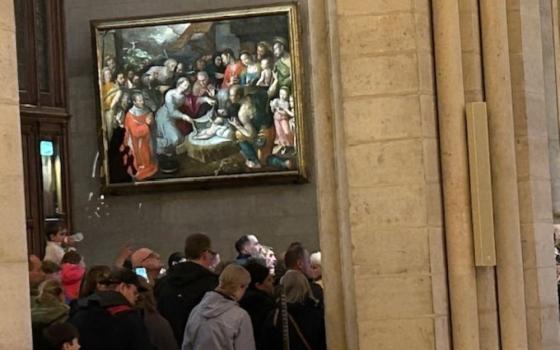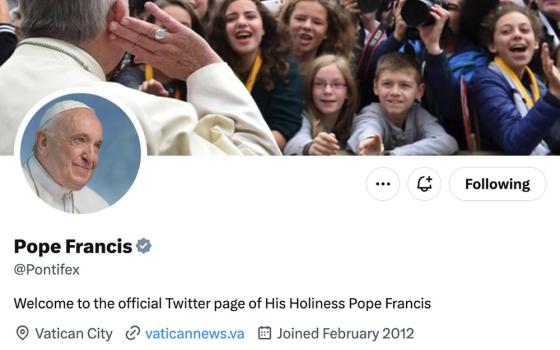Archbishop J. Augustine DiNoia, O.P. was named Vice-President of the Pontifical Commission “Ecclesia Dei” yesterday by Pope Benedict XVI. Archbishop DiNoia served with then-Cardinal Ratzinger at the Congregation for the Doctrine of the Faith for several years, then with Cardinal William Levada, before being named Secretary for the Congregation for Divine Worship in 2009 when he was also ordained titular Archbishop of Oregon City.
The Ecclesia Dei Commission was established by Pope John Paul II in 1988 to cultivate “full ecclesial communion of priests, seminarians, religious communities or individuals until now linked in various ways to the Fraternity founded by Archbishop Lefebvre.” As well, the commission aimed to promote the pastoral care of those Catholics who felt an attachment to the Tridentine Rites of the Church.
Several weeks ago, when there were rumors that a reconciliation between the Lefebvrists and the Holy See was imminent, I penned a short column entitled, “Welcome Back Lefebvrists.” I stand by what I wrote, most especially this: “Recall the parable of the lost sheep. The Master said that the good shepherd leaves the ninety-nine to go off in search of the one lost sheep. There is rejoicing when the lost sheep, the lost pearl, the prodigal, return. So let it be with the Lefebvrists if this news proves true and the reunion is affected.”
I was almost instantly attacked, not only in the comment section but at the website “Religion Dispatches” by University of Pennsylvania Professor Anthea Butler, who accused me of insensitivity to Jews among other charges. Of course, I had specifically mentioned that the anti-Semitism of some Lefebvrists was a continuing problem, one that would be easier to fix if they were inside the fold than out. And, given my many and repeated writings about Jews and Israel, writings which I think demonstrate my profound affection and respect for the Jewish faith, for the stock of Abraham and for the state of Israel, the charge of anti-Semitic bias was one that surprised me. I deny the charge.
But, back to Archbishop DiNoia. The task he has been assigned is one that will obviously require great theological sophistication, which happens to be one of DiNoia’s most obvious attributes. DiNoia is one of the three smartest people I have ever met, and the only Catholic in the trio. The issue is not the adherence of the Lefebvrists to this or that article in this or that document of Vatican II. The issue is how the entire Church understands Vatican II. For many Catholics, the Council was an ecclesiastical 180. Everything was new and everything was possible. The windows of the Vatican had been thrown open to let the Spirit in. As I have noted before, many understood the invitation to engage the world as an invitation to accommodate the Church to the world. There was no sense that open windows bring in foul smells as well as the Spirit. There was no sense that the world being engaged was itself in the last deathly gasps of modernism. As Karl Barth famously asked of Paul VI in an audience after the Council: “Aggiornamento? Accommodate yourself to what?” More importantly, Pope Benedict has been at pains to insist that Vatican II was not a rupture, that it contained elements of both continuity and discontinuity. Put differently, ecclesiology has different demands than the journalistic demands exercised by Xavier Rynne, who first cast Vatican II as a battle between left and right, between new and old, in his “Letters from Vatican City” that appeared in the New Yorker during the Council.
A Council unleashes a variety of centrifugal forces and after most Councils, the subsequent years, when the Council is being received by the entire Church, are times when the Church reintroduces centripetal forces. Many progressive Catholics have felt alienated by this reintroduction, starting with Humanae Vitae and continuing, even accelerating, during the pontificates of Pope John Paul II and Pope Benedict XVI. (It took more than 150 years after Trent for Rome to condemn Jansenism, a long simmering aspect of quasi-heretical and eventually thoroughly heretical reform efforts unleashed by Trent, but we live in faster times!) Progressive Catholics thought they were moving in one direction, only to be told to head back to the center. Something similar happened to the Lefebvrists, only it happened immediately after the Council. The direction in which they had been going since their youth was suddenly foreclosed. They experienced the Council as a rupture, just like their liberal counterparts, but they hated the new paths that were opened and which the liberals were moving down as fast as they could.
It seems to me, and I am no expert on the Holy Father’s motivations, and he has never given me his cell phone number so I can’t call him up and ask, but it seems to me that the whole significance of the effort to reconcile the Lefebvrists is not only an exercise in the core Petrine ministry of uniting the flock of Christ. It is an exercise in understanding the Council in the life of the Church. It is an effort to remind us that the Mass, whether it is in Latin and according to the Tridentine Rite, or in English according to the new Rite, or in the Ambrosian Rite, is still the one and the same Mass that was inaugurated by Jesus Christ at the Last Supper. The effort to reconcile with those who cling to the pre-Vatican II way of thinking is an effort to remind us that while the expression of the Church’s teachings change, the core of those teachings are the same, rooted in the Revelation of Jesus Christ and the Church’s on-going, never-ending reflection upon that Revelation. It is a reminder that when we speak of “the People of God” or invoke the “sensus fidelium” were are not speaking of mere democratic norms, that the People of God and the sense of the faithful, with whom we are called to communion, refers not only to our like-minded fellow parishioners, nor even to our contemporaries throughout the world. The “People of God” today is, and must be, in communion with the People of God of the fourth century and of the thirteenth century and, yes, of the Church circa 1959. We say this in the Creed every Sunday: “One, holy, catholic and apostolic Church.” That “One” has a meaning. We cannot simply look askance at the Lefebvrists who removed themselves from that One. The Pope is right to go after them and try to bring them back, to re-unite them with the rest of the flock.
The press release that announced Archbishop DiNoia’s appointment included these words: “In addition, the broad respect that Archbishop Di Noia enjoys in the Jewish community will help in addressing some issues that have arisen in the area of Catholic-Jewish relations as the journey towards the reconciliation of traditionalist communities has progressed.” One of the most significant achievements of Vatican II was “Nostra Aetate,” in which the Church found words from within its own tradition to set aside the ugly charge of deicide and to recognize God’s promises to the stock of Abraham as still valid. These teachings, fully orthodox and drawn from Paul’s Epistle to the Romans, have proven difficult for the Lefebvrists, but the difficulty is theirs and they must face it. The fact that Archbishop DiNoia has earned the respect of countless Jewish scholars, and is thoroughly familiar with Jewish theology, will undoubtedly help him in his task of helping the Lefebvrists to see what the Council Fathers, and St. Paul, saw: God does not go back on His promises, not to Israel, not to anyone, and all of us who sin should hold ourselves accountable for the crucifixion of Jesus. I once heard then-Father DiNoia take on the Ur-text of anti-Semitism – “Let his blood be upon us and upon our children” – in a Good Friday homily in which he pointed out that we want that blood on us and upon our children because, as Christians, we believe that Christ’s blood is what saves us. The Jewish community need have no fears that any reconciliation with the Lefebvrists will be purchased by winking at Nostra Aetate.
I am sure that many will take umbrage at the fact that so much effort is being spent on people who have already gone into schism while the LCWR is put into the hot seat by the CDF. Similar aspersions were thrown at Pope Benedict when he announced the new ordinariates for Anglicans who wish to return to Rome. Of course, in Rome’s eyes, if someone has left and wants to come back, you encourage them to keep moving towards the center, but if someone is still inside the fold, but in danger of leaving, you try to discourage them from continuing down the path they are on. I am not going to defend the handling of the LCWR investigation and I fault mainly the U.S. bishops for failing to engage women religious in ways that could prevent the steps Rome felt obliged to take. If you think someone is singing bad music, it is always better to teach them better music, rather than to slam the piano cover down on their fingers. The bishops did not teach better music, they simply asked Rome to slam the piano cover down on the LCWR’s fingers. But, I understand both why some people see the differing treatments meted out as frustrating and I see, too, why Rome has meted out different treatments.
Archbishop DiNoia’s task is not an enviable one. The Lefebvrists have a long history that pre-dates Vatican II. Their ancestors at La Croix and throughout the French Church were as disloyal to Pope Leo XIII in the 1890s as they were to Pope Paul VI in the 1960s. They can be very difficult and truculent. But, if they want to come home, and they are willing to understand why Vatican II rearranged the furniture in important ways, but threw nothing essential away and certainly did not remove the foundation, then I hope they can see their way to be reconciled with the Church. They, too, should benefit from the “Here comes everybody” sensibility that is always latent in the heart of the Church.



